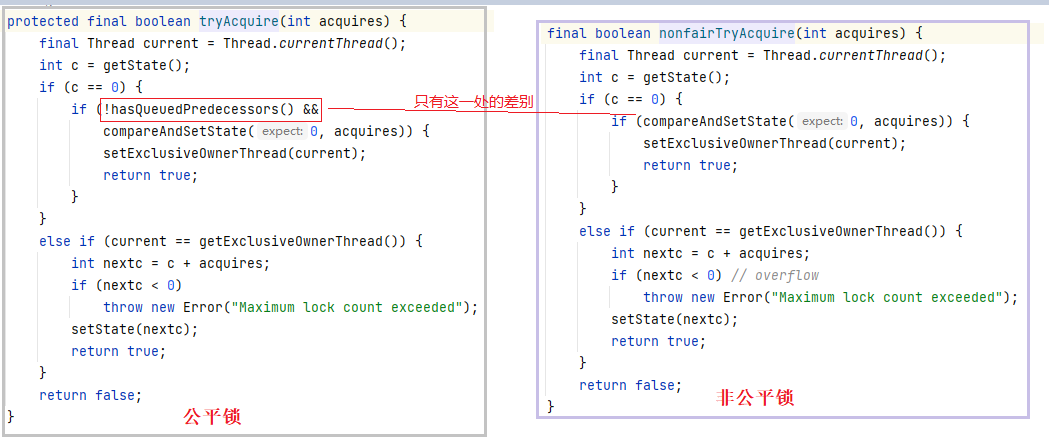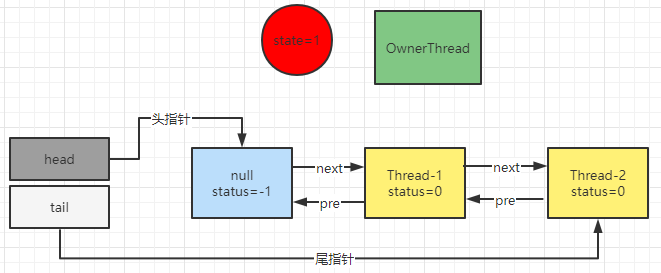【一知半解】AQS
2022-07-13 18:00:46
什麼是AbstractQueuedSynchronizer(AQS)
字面意思是抽象佇列同步器,使用一個voliate修飾的int型別的同步狀態,通過一個FIFO佇列完成資源獲取的排隊工作,把每個參與資源競爭的執行緒封裝成一個Node節點來實現鎖的分配。
AbstractQueuedSynchronizer原始碼
public abstract class AbstractQueuedSynchronizer
extends AbstractOwnableSynchronizer
implements java.io.Serializable {
private transient volatile Node head;//連結串列頭
private transient volatile Node tail;//連結串列尾
private transient Thread exclusiveOwnerThread;//持有鎖的執行緒
private volatile int state;//同步狀態,0表示當前沒有執行緒獲取到鎖
static final class Node {//連結串列的Node節點類
volatile int waitStatus;//當前節點在佇列中的狀態
volatile Node prev;//前置節點
volatile Node next;//後置節點
volatile Thread thread;//當前執行緒
}
}
AQS同步佇列的基本結構

Node.waitStatus的說明
| 狀態值 | 描述 |
|---|---|
| 0 | 節點預設的初始值 |
| SIGNAL=-1 | 執行緒已經準備好,等待釋放資源 |
| CANCELLED=1 | 獲取鎖的請求執行緒被取消 |
| CONDITION=-2 | 節點在佇列中,等待喚醒 |
state為什麼要用volatile修飾?
- 可見性,一個執行緒對變數的修改可以立即被別的執行緒感知到
- 有序性,禁止指令重排
AQS獲取鎖步驟
public final void acquire(int arg) {
if (!tryAcquire(arg) &&
acquireQueued(addWaiter(Node.EXCLUSIVE), arg))
selfInterrupt();
}
- 當一個執行緒獲取鎖時,首先判斷state狀態值是否為0
- 如果state==0,則通過CAS的方式修改為非0狀態
- 修改成功,則表明獲取鎖成功,執行業務程式碼
- 修改失敗,則把當前執行緒封裝為一個Node節點,加入到佇列中並掛起當前執行緒
- 如果state!=0,則把當前執行緒封裝為一個Node節點,加入到佇列中並掛起當前執行緒
AQS獲取鎖過程
首先呼叫tryAcquire去修state的狀態值,成功就獲取當前鎖;失敗則加入當前等待佇列中,然後掛起執行緒。
tryAcquire
在AQS的原始碼中tryAcquire是一空實現,需要它的子類去實現這個空方法。因為在AQS中雖然公平鎖和非公平鎖的都是基於一個CLH去實現,但是在獲取鎖的過程中略有不同。
protected boolean tryAcquire(int arg) {
throw new UnsupportedOperationException();
}
公平鎖FairSync#tryAcquire
protected final boolean tryAcquire(int acquires) {
//獲取當前執行緒
final Thread current = Thread.currentThread();
int c = getState();//獲取同步器的狀態
if (c == 0) {//當前沒有執行緒獲取到鎖
//首先判斷祖宗節點的執行緒是否當前執行緒一樣
if (!hasQueuedPredecessors() &&
//更改state的狀態值為非0
compareAndSetState(0, acquires)) {
setExclusiveOwnerThread(current);
return true;
}
}
//如果鎖持有者的執行緒是當前執行緒,則可放行,鎖的重入
else if (current == getExclusiveOwnerThread()) {
int nextc = c + acquires;
if (nextc < 0)
throw new Error("Maximum lock count exceeded");
setState(nextc);
return true;
}
return false;
}
}
/**
* 判斷祖宗節點的執行緒是否當前執行緒一樣
* 傀儡節點的下個節點
*/
public final boolean hasQueuedPredecessors() {
Node t = tail;
Node h = head;
Node s;
//頭節點的下個節點所持有的執行緒是否與當前執行緒相同
return h != t &&
((s = h.next) == null || s.thread != Thread.currentThread());
}
非公平鎖NonfairSync#tryAcquire
protected final boolean tryAcquire(int acquires) {
return nonfairTryAcquire(acquires);
}
final boolean nonfairTryAcquire(int acquires) {
final Thread current = Thread.currentThread();
int c = getState();
if (c == 0) {
//通過CAS更改state的狀態值
if (compareAndSetState(0, acquires)) {
//把當前執行緒設定為鎖的持有者
setExclusiveOwnerThread(current);
return true;
}
}
//如果鎖持有者的執行緒是當前執行緒,則可放行,鎖的重入
else if (current == getExclusiveOwnerThread()) {
int nextc = c + acquires;
if (nextc < 0) // overflow
throw new Error("Maximum lock count exceeded");
setState(nextc);
return true;
}
return false;
}

對比後發現,公平鎖先判斷是否有老祖宗節點,如果有則返回false;如果當前執行緒對應的node就是老祖宗節點,則直接去修改state狀態,把state改為非0。
addWaiter
獲取鎖成功的執行緒去執行業務邏輯了,獲取鎖失敗的執行緒則會在佇列中排隊等候,每個等候的執行緒也都不安分的。
private Node addWaiter(Node mode) {
//把當前執行緒封裝為一個Node節點
Node node = new Node(Thread.currentThread(), mode);
Node pred = tail;
if (pred != null) {
node.prev = pred;
if (compareAndSetTail(pred, node)) {
pred.next = node;
return node;
}
}
//加入到佇列的尾部
enq(node);
return node;
}
- 把當前執行緒封裝為一個Node節點
- 當第一次執行這個方法時,由於head和tail都還沒有賦值,則pred指向的tail也是空,所以直接直到
enq(node) - 當pred指向的tail不為空時,則通過CAS的方式加入到尾部,如果成功直接返回;如果失敗,則進入
enq(node)通過自旋的方式加入。
//通過自旋的方式將節點加入到節點的尾部
private Node enq(final Node node) {
for (;;) {
Node t = tail;
if (t == null) { // Must initialize
if (compareAndSetHead(new Node()))
tail = head;
} else {
node.prev = t;
if (compareAndSetTail(t, node)) {
t.next = node;
return t;
}
}
}
}
為了操作連結串列的方便,一般都要在連結串列的頭前加入一個傀儡節點,AQS的連結串列也不例外。
先建立一個傀儡節點,並把head、tail均指向它,然後再把node節點加入到尾部後面,移動tail的指向。
acquireQueued
當節點成功加入到連結串列的尾部後,等待被喚醒,然後通過自旋的方式去獲取鎖
final boolean acquireQueued(final Node node, int arg) {
boolean failed = true;
try {
boolean interrupted = false;
for (;;) {
//當前節點的前置節點
final Node p = node.predecessor();
//如果前置節點是傀儡節點(head指向傀儡節點),則再次嘗試去獲取鎖
if (p == head && tryAcquire(arg)) {
//獲取成功後,則移除之前的傀儡節點,head指向當前node,
setHead(node);
p.next = null; // help GC
failed = false;
return interrupted;
}
//獲取鎖失敗後,設定node節點的狀態,並掛起當前節點
if (shouldParkAfterFailedAcquire(p, node) &&
parkAndCheckInterrupt())
interrupted = true;
}
} finally {
if (failed)
cancelAcquire(node);
}
}
- 獲取node節點的前置節點,如果前置節點是head,則再次嘗試去獲取鎖
- 設定當前node節點的前置節點狀態為-1(表示後續節點正在等待狀態,預設是0),然後通過自旋的後會進行到
parkAndCheckInterrupt掛起當前節點 LockSupport.park(this)執行完事,當前執行緒會一直阻塞到這個地方- 當前喚醒時再次從1開始執行

AQS釋放鎖過程
public final boolean release(int arg) {
if (tryRelease(arg)) {
Node h = head;
if (h != null && h.waitStatus != 0)
unparkSuccessor(h);
return true;
}
return false;
}
主要是恢復state的值、重置鎖持有都執行緒,然後喚醒掛起的執行緒。
protected final boolean tryRelease(int releases) {
int c = getState() - releases;
//當前執行緒與鎖持有者執行緒不一樣會報錯
if (Thread.currentThread() != getExclusiveOwnerThread())
throw new IllegalMonitorStateException();
boolean free = false;
if (c == 0) {//重入的次數為0時,則當前執行緒已經沒有重入了,可以清空鎖的持有者
free = true;
setExclusiveOwnerThread(null);
}
setState(c);
return free;
}
恢復state狀態的值,如果重入次數為0時,則清空鎖的持有都為null
private void unparkSuccessor(Node node) {
int ws = node.waitStatus;
if (ws < 0)
compareAndSetWaitStatus(node, ws, 0);
Node s = node.next;
if (s == null || s.waitStatus > 0) {
s = null;
for (Node t = tail; t != null && t != node; t = t.prev)
if (t.waitStatus <= 0)
s = t;
}
if (s != null)//喚醒下個node對應的執行緒
LockSupport.unpark(s.thread);
}
設定head指向的node節點的watiStatus的狀態值,然後找到下個節點對應的執行緒並喚醒。